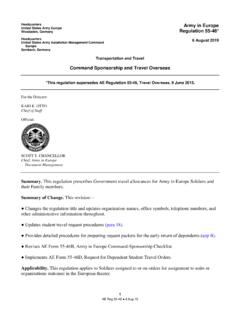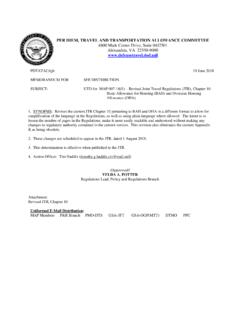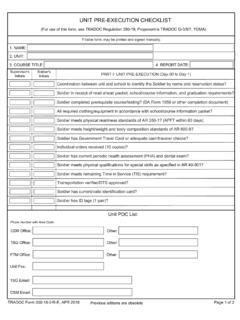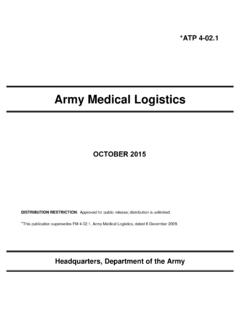Transcription of Opposing Force Tactics - United States Army
1 TC ForceTacticsDecember 2011 DISTRIBUTION RESTRICTION:Approved for public release; distribution is OF THE army This publication is available at army Knowledge Online ( ); General Dennis J. Reimer Training and Doctrine Digital Library ( ). TC Distribution Restriction: Approved for public release; distribution is unlimited. i Training Circular No. Headquarters Department of the army Washington, , 9 December 2011 Opposing Force Tactics Contents Page PREFACE .. ix INTRODUCTION .. x Operational Environments .. x Opposing Force .. xi The COE and OPFOR Continue to Evolve .. xv Chapter 1 STRATEGIC AND OPERATIONAL FRAMEWORK .. 1-1 National-Level Organization .. 1-1 National Security Strategy .. 1-4 Strategic Campaign .. 1-7 Operational-Level Organization.
2 1-8 Operational Designs .. 1-10 Types of Offensive and Defensive Action .. 1-12 Systems Warfare .. 1-13 The Role of Paramilitary Forces in Operations .. 1-16 Chapter 2 COMMAND AND CONTROL .. 2-1 Concept and Principles .. 2-1 Command and Support Relationships .. 2-2 Tactical-Level Organizations .. 2-3 Organizing the Tactical Battlefield .. 2-11 Functional Organization of Forces and Elements .. 2-15 Headquarters, Command, and 2-17 Command Posts .. 2-28 Command and Control Systems .. 2-31 Chapter 3 OFFENSE .. 3-1 Purpose of the Offense .. 3-1 Planning the Offense .. 3-3 Preparing for the Offense .. 3-8 Executing the Offense .. 3-8 Types of Offensive Action Tactical Groups, Divisions, and Brigades .. 3-9 Tactical Offensive Actions Detachments, Battalions, and Below .. 3-20 Contents ii TC 9 December 2011 Chapter 4 DEFENSE .. 4-1 Purpose of the Defense .. 4-1 Planning the Defense.
3 4-2 Preparing for the Defense .. 4-7 Executing the Defense .. 4-9 Types of Defensive Action Tactical Groups, Divisions, and Brigades .. 4-10 Tactical Defensive Actions Detachments, Battalions, and Below .. 4-18 Chapter 5 BATTLE DRILLS .. 5-1 Purpose of Battle Drills .. 5-1 Actions on Contact .. 5-1 Breaking Contact .. 5-4 Situational Breach .. 5-5 Fire and Maneuver .. 5-7 Fixing .. 5-9 Chapter 6 OTHER COMBINED ARMS ACTIONS .. 6-1 Actions of the Disruption Force .. 6-1 Counterreconnaissance .. 6-2 Antilanding Actions .. 6-6 Urban Combat .. 6-7 Chapter 7 INFORMATION WARFARE .. 7-1 Tactical-Level INFOWAR .. 7-1 Elements of INFOWAR .. 7-3 Chapter 8 RECONNAISSANCE .. 8-1 Combined Arms Mission .. 8-1 Concept .. 8-2 Assets .. 8-4 Reconnaissance Planning .. 8-7 Reconnaissance Elements .. 8-12 Reconnaissance Methods .. 8-16 Chapter 9 INDIRECT FIRE SUPPORT .. 9-1 Fire Support Concepts.
4 9-1 Indirect Fire Support Weapons .. 9-3 Command and Control .. 9-4 Fire Support Planning .. 9-11 Targeting .. 9-12 Target Acquisition and Reconnaissance .. 9-15 Methods of Fire .. 9-18 Fire Support of Maneuver Operations .. 9-19 Tactical Deployment .. 9-20 Logistics .. 9-25 Chapter 10 AVIATION .. 10-1 Command and Control .. 10-1 Airspace Management .. 10-5 Missions .. 10-10 Planning and Preparation .. 10-19 Contents 9 December 2011 TC iii Flight Tactics .. 10-27 Chapter 11 AIR DEFENSE .. 11-1 Air Defense System .. 11-1 Command and Control .. 11-4 Air Surveillance .. 11-7 Tactical Assets .. 11-10 Employment .. 11-13 Nonlethal Air Defense 11-27 Chapter 12 ENGINEER SUPPORT .. 12-1 Adaptive Engineer Support .. 12-1 Missions and Tasks .. 12-1 command and control .. 12-4 Support to Information Warfare .. 12-5 Engineer Reconnaissance .. 12-5 Mobility .. 12-7 Countermobility.
5 12-19 Survivability .. 12-30 Chapter 13 CBRN AND SMOKE .. 13-1 Weapons of Mass Distruction .. 13-1 Preparedness .. 13-1 Staff Responsibility .. 13-2 Chemical Warfare .. 13-2 Biological Warfare .. 13-6 Radiological Weapons .. 13-8 Nuclear Warfare .. 13-9 CBRN Protection .. 13-11 13-17 Chapter 14 LOGISTICS .. 14-1 Stratecic and Operational Logistics Support .. 14-1 Tactical Staff Responsibilities .. 14-1 Tactical Logistics Concepts .. 14-3 Logistics 14-3 Tailored Logistics Units .. 14-4 Materiel Support .. 14-7 Maintenance .. 14-9 Transportation .. 14-9 Personnel Support .. 14-12 Medical Support .. 14-13 Support of Combat Actions .. 14-14 Post-Combat Support .. 14-16 Chapter 15 SPECIAL-PURPOSE FORCES AND COMMANDOS .. 15-1 SECTION I SPECIAL-PURPOSE FORCES .. 15-1 Command and Control .. 15-1 Missions .. 15-2 Organization for combat .. 15-5 Contents iv TC 9 December 2011 SPF Brigades, Battalions, Companies, and Teams.
6 15-6 Tactics , Techniques, and Procedures .. 15-18 Equipment .. 15-21 Personnel .. 15-22 Logistics .. 15-23 SECTION II COMMANDOS .. 15-25 Command and Control .. 15-25 Missions .. 15-25 Organization for Combat .. 15-27 Commando Brigades and Battalions .. 15-27 Tactics , Techniques, and Procedures .. 15-33 Personnel .. 15-34 Chapter 16 MARKSMEN AND SNIPERS .. 16-1 Similarities and Differences .. 16-1 Marksmen .. 16-1 Snipers .. 16-4 Antimateriel Role .. 16-9 Role in Information Warfare .. 16-11 Differences Between Regular Military Snipers and Irregular Force Snipers .. 16-11 GLOSSARY .. Glossary-1 REFERENCES .. References-1 INDEX .. Index-1 Figures Figure 1-1. National Command Authority .. 1-2 Figure 1-2.
7 The State s armed forces .. 1-3 Figure 1-3. Conceptual framework for implementing the State s national security strategy .. 1-4 Figure 1-4. Example of a strategic campaign .. 1-7 Figure 1-5. State and OPFOR planning framework .. 1-9 Figure 1-6. Operational designs .. 1-11 Figure 1-7. Combat system .. 1-14 Figure 2-1. Possible DTG organization (example) .. 2-5 Figure 2-2. Possible BTG organization (example) .. 2-5 Figure 2-3. Motorized infantry-based DTG symbol .. 2-6 Figure 2-4. Mechanized infantry-based DTG symbol .. 2-6 Figure 2-5. Tank-based BTG symbol .. 2-6 Figure 2-6. Battalion example .. 2-7 Figure 2-7. Company (battery) example .. 2-7 Figure 2-8. Battalion-size detachment (BDET) example .. 2-8 Figure 2-9. Company-size detachment (CDET) example .. 2-8 Contents 9 December 2011 TC v Figure 2-10. Heliborne infantry-based BDET 2-9 Figure 2-11. Attack helicopter-based BDET symbol.
8 2-9 Figure 2-12. Mechanized infantry-based CDET symbol .. 2-10 Figure 2-13. Tank-based task-organized platoon symbol .. 2-10 Figure 2-14. Motorized infantry-based task-organized squad symbol .. 2-10 Figure 2-15. Linear AOR (example 1) .. 2-12 Figure 2-16. Linear AOR (example 2) .. 2-12 Figure 2-17. Nonlinear AOR (example 1) .. 2-13 Figure 2-18. Nonlinear AOR (example 2) .. 2-13 Figure 2-19. DTG or division command group and staff .. 2-18 Figure 2-20. Battalion command section and staff .. 2-27 Figure 3-1. Integrated attack (example 1) .. 3-10 Figure 3-2. Integrated attack (example 2) .. 3-11 Figure 3-3. Integrated attack (example 3) .. 3-12 Figure 3-4. Dispersed attack (example 1) .. 3-14 Figure 3-5. Dispersed attack (example 2) .. 3-15 Figure 3-6. Dispersed attack (example 3) .. 3-16 Figure 3-7. Spoiling attack (example) .. 3-18 Figure 3-8. Counterattack (example).. 3-19 Figure 3-9.
9 Assault (example 1) .. 3-21 Figure 3-10. Assault (example 2) .. 3-22 Figure 3-11. Assault (example 3) .. 3-23 Figure 3-12. Annihilation ambush (example 1) .. 3-30 Figure 3-13. Annihilation ambush (example 2) .. 3-30 Figure 3-14. Annihilation ambush (example 3) .. 3-31 Figure 3-15. Annihilation ambush using infantry antiarmor (hunter-killer) teams (example 4) .. 3-32 Figure 3-16. Harassment ambush (example) .. 3-33 Figure 3-17. Containment ambush (example 1) .. 3-34 Figure 3-18. Containment ambush (example 2) .. 3-35 Figure 3-19. Raid (example 1) .. 3-37 Figure 3-20. Raid (example 2) .. 3-37 Figure 3-21. Reconnaissance attack (example).. 3-42 Figure 4-1. Maneuver defense (example 1) .. 4-11 Figure 4-2. Maneuver defense (example 2) .. 4-13 Figure 4-3. Area defense (example 1).. 4-15 Figure 4-4. Area defense (example 2).. 4-16 Figure 4-5. Area defense (example 3).. 4-17 Figure 4-6.
10 Simple and complex battle positions .. 4-19 Figure 4-7. Combat security outpost (example) .. 4-21 Figure 4-8. CDET in an SBP (example 1) .. 4-22 Contents vi TC 9 December 2011 Figure 4-9. CDET in an SBP (example 2) .. 4-23 Figure 4-10. Reconnaissance support to an SBP (example) .. 4-25 Figure 4-11. Defense of a CBP (example) .. 4-30 Figure 4-12. CSOPs in the disruption zone supporting a CBP (example 1) .. 4-32 Figure 4-13. CSOPs in the disruption zone supporting a CBP (example 2) .. 4-33 Figure 4-14. Reconnaissance support to a CBP (example) .. 4-34 Figure 5-1. Actions on contact (example) .. 5-3 Figure 5-2. Breaking contact (example) .. 5-4 Figure 5-3. Situational breach (example) .. 5-6 Figure 5-4. Fire and maneuver (example) .. 5-8 Figure 5-5. Fixing (example) .. 5-10 Figure 6-1. Counterreconnaissance detachment (example) .. 6-4 Figure 6-2. Execution of counterreconnaissance (example).













